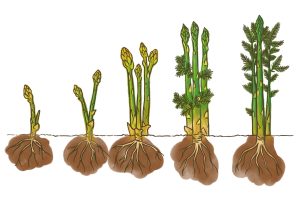Asparagus is one of the first plants to let us know Spring has arrived.
The most edible part of asparagus emerges as soil temperatures reach 50º. And with it the anticipation of fresh veggies straight from the garden to our tables.
About Asparagus
Asparagus is a perennial vegetable that is known to be productive for 15 – 20 years with very little maintenance. It takes 2-3 years to be fully productive. But worth the wait.
Asparagus plants are either male or female. Female asparagus produces seeds. Male asparagus does not spend energy producing seeds, so they are three times more productive. For this reason, male plants are often preferred.
Planting Asparagus
Choose a place that gets full sun (at least 6 – 8 hours of sun per day) with good drainage. Asparagus roots will rot if kept too wet. Raised beds with plenty of organic matter are a great option.
 Plant one year old crowns in early Spring as soon as the ground can be worked.
Plant one year old crowns in early Spring as soon as the ground can be worked.
Soak crowns briefly in lukewarm water before planting.
Dig a trench 12 – 18 inches wide and 6 – 8 inches deep. If digging more than one trench space them 3 feet apart.
Create a 2″ mound in the middle of the trench using soil mixed with organic matter and a starting fertilizer.
Place crowns on the mound with the eye facing up and the roots spread over the mound about 12 – 18 inches apart. Be sure to avoid allowing their roots to touch, as this can cause them to mold.
You can cover the crowns with soil and organic matter a little at a time over the course of the season or you can cover them all at once. Either way works, as long as the soil is fairly loose so the spears can come through easily.
Be sure to water the crowns in thoroughly after planting. For the first two years after planting, water deeply about once per week allowing them to dry out in between. Once established, asparagus is fairly drought tolerant.
It is very important to keep weeds well managed. Asparagus does not like their roots disturbed so hand weeding is best.
Harvesting Asparagus
Year One – DO NOT harvest at all, allow the ferns to grow and mature. This replenishes the nutrients for next years’ crop.
Year Two – Harvest lightly and only the spears that are larger than a pencil.
Year Three – You may harvest as much as you like. Asparagus can keep producing for up to 8 weeks. Once spears decrease in size to smaller than a pencil it is time to stop harvesting.
Be sure to allow the ferns to grow an mature to nourish the next years’ crops. Do not cut them down until after the first frost. Fertilize in Summer after harvesting is complete and add a layer of mulch to keep weeds at bay in the Fall.

Some Great Ways to Enjoy Asparagus
Have you tried it grilled on the barbecue? One of the easiest and most delicious ways to enjoy asparagus takes just a couple of minutes and a few ingredients.
Grilled Asparagus
Simply wash and pat your spears dry. Coat with a bit of olive oil, salt, and pepper. Grill on the barbecue for 5-7 minutes until they reach desired tenderness. Pair with a nice grilled steak or salmon and you have a fantastic fancy home cooked meal!
How about an awesome appetizer? Like peanut butter and jelly, bacon and asparagus are a perfect pair!
Bacon Wrapped Asparagus
- 1 pkg bacon (unprocessed, nitrate free)
- Asparagus
- Olive oil
- Salt
- Pepper
Bake bacon on a cookie sheet in the oven at 350 for 5 minutes. Take it out and wrap each piece of asparagus (or a small bunch of 3-5) with strips of bacon as desired (careful, it’s warm).
Drizzle a little olive oil over the top and sprinkle with salt and pepper.
Return to oven for 10 more minutes, turning once or twice until bacon is crispy. Serve immediately.

